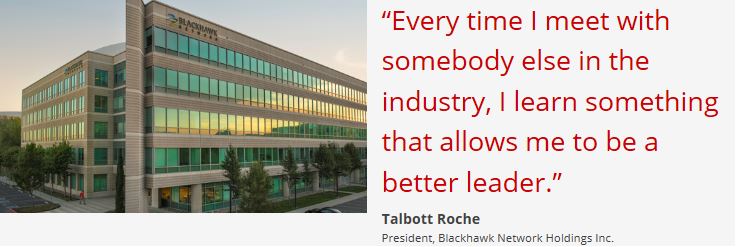Talbott Roche has the team and the strategy to help Blackhawk Network dominate

The transition from small entrepreneurial company to global industry pioneer has been both challenging and rewarding, says Talbott Roche, president at Blackhawk Network Holdings Inc.
“When we started the company, there was no concept of selling a gift card in a third-party environment,” she says.
“We created a new category that now exists inside 150,000 retailers around the world. We offer prepaid products, something that had never been done before. It was very challenging to evangelize this new concept that we’re going to make buying a gift card in a grocery store as easy as buying any other item on the rack.”
That was in 2001. Fourteen years later, the rack of gift cards at the grocery store is a primary destination for the couple heading out to dinner and a movie, children who need a quick gift to slide in their Mother’s Day cards or the manager who wants to reward an employee for a job well done.
It’s the place to go to buy gift cards and Blackhawk Network, which took in $1.4 billion in revenue in 2014, is the company that helped make it all possible. Roche gives the credit for this success to her executive team and the rest of the company’s 1,860 employees.
“The folks who lead the company and who work at the company are the ones who make the difference,” Roche says. “To me, a high-functioning team is one where you have diversity of thought, but you also have a tremendous level of trust.”
Roche joined Blackhawk in July 2001 as an assistant vice president.
At the time, the company was still a specialty marketing division of Safeway Inc. Blackhawk was incorporated in 2006 and became publicly traded in April 2013. Roche was named the company’s president in November 2010.
One key to having such a strong team is leadership that has the discipline to take a great idea and make sure every detail is addressed to enable the idea to live up to its full potential.
“It isn’t just about what’s the next hot product we can put on the shelf,” Roche says. “It’s also how do we do it in a scalable and efficient manner.”
Focus on the details
In developing the concept of selling gift cards in a third-party environment, Blackhawk had to set up the systems and technology that would support the new product.
“One of the things we had to step back and look at in our business was where can we be more efficient?” Roche says. “Where can we insource some of the capabilities? We decided to insource our own processing, which was a strategic decision because that was going to be fundamental to our business. We insourced a lot of our customer care so we could control the customer’s end experience.
“That was a transformation for us. We really went from thinking about the entrepreneurial perspective of what’s the new product we can put out there in the marketplace to how do we operate it at scale and continue to innovate at the same time we’re making our core business more efficient? So it’s doing those two things simultaneously.”
Patience is a vital part of launching a new product. You sometimes have to resist that excitement a bit to make sure the actual opportunity matches your enthusiastic vision.
“You have to take the time to plan in advance to think No. 1, can this be large enough to create meaningful value when you’re a larger entity?” Roche says.
“No. 2, how am I going to build it to scale? Will it scale? Is it attractive enough? Is it a big enough opportunity? Will it have a powerful enough value proposition to be meaningful across my entire network? How am I going to make it across that network in an efficient and effective manner? What are the processes and resources necessary in order to do this correctly?”
The dynamics of your organization tend to change when you go from a smaller entrepreneurial company to a larger business.
“When you become larger, you have to have cross-functional teams to get these products to market because they touch lots of different systems,” Roche says. “They require different functional support to be scaled into the market and it’s just a different mindset. It requires more planning upfront and a real commitment by the team to superior execution.”
The skill of Roche and her team was put to the test when Blackhawk sought a deal with Visa. Up to that point, the focus had been on retail-branded gift cards such as Nordstrom, The Home Depot and Starbucks.
“We saw an opportunity to introduce network-branded, or open loop cards — Visa, MasterCard, American Express — which could be redeemed at any retail outlet that accepts those types of cards,” Roche says. “When we first met with Visa, they were very resistant to the idea.”
Blackhawk had to step up and present a value proposition that reflected the success that had already been achieved and the potential opportunity that awaited Visa if it came on-board.
“We had to invest in the systems, risk controls, fraud controls and different processes to bring this to market,” Roche says. “We had to contract with banks, which we had not previously contracted with and have a very well thought-out plan, as well as a spirit of innovation of our willingness to commit to creating a new product that never existed before.
“It was invention, but it was invention that had to be very well thought through and planned out. We were able to scale it and today, we’re doing billions in open network gift cards and it’s our most successful gift card on the rack.”
Embrace conflict
Roche does not want a team that agrees with her at every turn. Quite the contrary, she embraces conflict and believes it leads to a better decision for her business.
“We can have a really healthy debate and bring all the disparate points of view to the table, debate them and come away with what I think is the best strategy,” Roche says. “If you can’t embrace that conflict while you’re formulating your strategy, you won’t come up with the best strategy. You need to consider all the different functional points of view in how you do things.”
This ability to work through disagreement to reach the best solution should begin at the top. It showed itself when Blackhawk was making five acquisitions over the last two years and Roche and her team spent a lot of time evaluating different assets in the marketplace.
“There may have been a time where I wanted to go in one direction and other members of the team wanted to pursue a different asset,” Roche says. “Through the debate, we actually came up with the best conclusion. That was for me to allow the team to challenge my point of view and actually change my point of view.
“Particularly when you’re thinking about acquisitions, you need to think about the fit within your company. That’s an example of where I think we made a better decision as a company because I invited the team to challenge me. Leaders do that and they should do that.”
One of the challenges in a growing business is that the top leaders can sometimes become more detached from the rest of the organization just from the sheer increase in people and responsibilities that come about.
“It’s harder to do when you’re larger, but it’s something I’m always working on,” Roche says. “We’re stronger when I make decisions that are informed by my team.”
As Roche continually works to strengthen her bond with Blackhawk’s internal team, she also devotes a lot of energy to an external network that she has built up over the years.
She called upon this group when the credit card business came under scrutiny from the federal government after the financial meltdown in 2008.
“It could have been devastating to many of us in the marketplace and could have changed gift cards for consumers forever,” Roche says. “But by being able to reach out to that network and call on them and bring them together to work on the issues collaboratively, we were able to fix what could have been a devastating situation.”
Often, this external network is just as important as the team you talk to and trust within your business.
“Every time I meet with somebody else in the industry, I learn something that allows me to be a better leader,” Roche says. “I can’t imagine running this business and not doing that, especially if you’re a high-growth business. You’re always looking for ideas on how you can improve or new products you can bring to market or new ideas on how to better manage your business.”
As she looks to the future, Roche is thinking a lot about the digital realm.
“Digital is transformative for us because it allows us to take the services we represent in the physical retail channels and think of our services as a platform and expand them into digital markets,” Roche says. “It’s another opportunity for growth.”
Takeaways
-
Be detail-oriented when evaluating growth opportunities.
-
Give your team what it needs to help you help your business.
-
Build and maintain a network of external support.
Source: Smart Business Online
MEDIA CONTACT:
KATY LASEE | MARKETING DEPT.
651 554 8533
KRLasee@traveltags.com
TAGS:
Blackhawk Network Holdings,
card manufacturing



